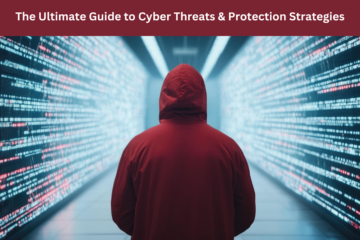The Future of Ethical Hacking: A Guide to Emerging Trends, Techniques, and Challenges
As we enter an era dominated by technology, cybersecurity has become a paramount concern. Ethical hacking, the art of identifying vulnerabilities before malicious actors can exploit them, is integral in safeguarding sensitive information and systems. In today’s rapidly evolving digital landscape, cyber threats are more advanced than ever, and ethical hackers need to stay ahead of the curve to ensure security. This article delves into the future of ethical hacking, highlighting the emerging trends, advanced techniques, and the challenges cybersecurity professionals will face.
Emerging Trends in Ethical Hacking
1. AI and Machine Learning in Ethical Hacking
Artificial Intelligence (AI) and Machine Learning (ML) are revolutionizing cybersecurity. These technologies enable ethical hackers to automate vulnerability detection, enhance penetration testing, and even predict future cyberattacks. With AI-driven tools, security professionals can analyze massive amounts of data quickly, uncovering loopholes that would be nearly impossible for a human to detect manually. Machine learning also allows for the development of self-learning malware that can adapt to bypass detection tools. These advancements make the identification of security flaws faster and more efficient, thus enhancing overall system security.
2. Cloud Security Testing
As businesses increasingly move their infrastructure to cloud-based environments, the need for cloud security testing has skyrocketed. Ethical hackers are now tasked with evaluating cloud platforms to ensure they are free from security gaps. Cloud penetration testing involves assessing various cloud services and configurations, ensuring that they comply with security standards and best practices. This kind of testing helps identify potential threats like data breaches, unauthorized access, and misconfigurations, which can lead to significant security risks. With cloud adoption continuing to rise, cloud security testing is set to play an even more critical role in the future of ethical hacking.
3. Securing the Internet of Things (IoT)
The Internet of Things (IoT) is expanding at an exponential rate, with everything from home appliances to industrial devices being connected to the internet. While this connectivity has benefits, it also creates a significant attack surface for cybercriminals. Ethical hackers are focusing on securing IoT devices, ensuring that weak points like poor authentication mechanisms and unencrypted data transmission are addressed. By evaluating IoT security, ethical hackers can prevent unauthorized access, mitigate data exposure, and ensure that vulnerabilities in connected devices are patched before they can be exploited.
4. Blockchain and Cryptocurrency Security
Blockchain technology is becoming increasingly popular, particularly in the world of cryptocurrency. However, with its rise, so too have the security challenges associated with decentralized applications (DApps), smart contracts, and cryptocurrency transactions. Ethical hackers are exploring vulnerabilities within blockchain systems, looking for potential exploits that could lead to fraud or financial loss. Security audits of blockchain applications are essential to ensure that the smart contracts deployed are secure, and that transactions are not vulnerable to manipulation or theft. As the use of blockchain grows, the need for ethical hackers to secure these technologies becomes ever more critical.
5. Red Team vs. Blue Team Simulations
In ethical hacking, simulations play a crucial role in testing and improving security systems. Red team exercises involve ethical hackers simulating real-world cyberattacks, while blue teams defend against these simulated attacks. These exercises help organizations understand their vulnerabilities and improve their security protocols. Red team vs. blue team simulations provide valuable insights into how well an organization can withstand sophisticated cyberattacks, ensuring that defenses are strong enough to mitigate evolving threats. The future will see even more widespread use of these simulations as part of an organization’s proactive cybersecurity strategy.
Advanced Ethical Hacking Techniques
1. Social Engineering and Phishing Attacks
Social engineering continues to be one of the most effective attack vectors for cybercriminals. Ethical hackers use sophisticated phishing techniques, deepfake technology, and psychological manipulation to test human vulnerabilities within organizations. The rise of AI-generated content makes it easier for hackers to create convincing fake identities or scenarios that trick employees into compromising sensitive data or systems. Ethical hackers use these same techniques to simulate these attacks and identify weaknesses in human decision-making processes.
2. Automated Exploit Development
Tools like Metasploit, along with custom exploit scripts, allow ethical hackers to rapidly identify and exploit system vulnerabilities. These tools can be used to test for zero-day vulnerabilities—those that have not yet been discovered or patched by the software vendor. Automated exploit development saves time, making the process of vulnerability detection more efficient and systematic. It also allows ethical hackers to discover complex weaknesses that might otherwise be overlooked during manual testing.
3. AI-Powered Penetration Testing
AI-driven penetration testing is transforming the way ethical hackers conduct security assessments. By simulating attacks in real-time, AI-powered tools provide detailed vulnerability assessments that can identify both common and obscure threats. These tools can autonomously probe systems, network infrastructures, and web applications for weaknesses, providing a comprehensive overview of potential security issues. This automation makes penetration testing faster and more scalable, allowing ethical hackers to test larger, more complex systems than ever before.
4. Steganography and Covert Channels
Steganography is a technique that allows malicious payloads to be hidden within images, videos, or even network traffic. Ethical hackers use this technique to assess how well security systems can detect covert channels used for data exfiltration. By embedding payloads in seemingly benign files, ethical hackers can evaluate whether data can be securely transmitted without being detected by traditional security tools. This technique is particularly relevant in a world where cybercriminals increasingly employ stealth methods to evade detection.
5. Bypassing Multi-Factor Authentication (MFA)
While multi-factor authentication (MFA) is widely regarded as one of the most secure forms of user authentication, attackers have found ways to bypass it. Ethical hackers are exploring vulnerabilities in MFA systems, such as session hijacking, push notification spamming, and social engineering attacks, to test the resilience of authentication mechanisms. By simulating these attacks, ethical hackers can help organizations strengthen their MFA protocols and prevent unauthorized access to critical systems.
Cybersecurity Challenges in Ethical Hacking
1. Evolving Threat Landscape
As technology advances, so do the tools and techniques used by cybercriminals. Hackers are constantly developing new attack vectors, making it increasingly difficult for ethical hackers to stay ahead of emerging threats. With the proliferation of IoT, cloud computing, and AI-driven attacks, the cybersecurity landscape is continuously changing. Ethical hackers must be vigilant and adaptive, constantly updating their skill sets to combat new and sophisticated threats.
2. Legal and Ethical Dilemmas
Ethical hacking is governed by strict legal frameworks, but issues can arise when security tests are conducted without explicit permission. Even though ethical hackers have the best intentions, unauthorized testing of systems can lead to legal repercussions. Understanding and adhering to regulations like GDPR (General Data Protection Regulation) and CCPA (California Consumer Privacy Act) is crucial to ensuring that ethical hacking activities are both legal and effective.
3. Shortage of Skilled Professionals
The demand for skilled ethical hackers is outpacing supply. With the ever-increasing complexity of cyber threats, organizations need more cybersecurity experts to combat these challenges. The shortage of skilled professionals is a significant barrier to improving cybersecurity defenses, and the industry must focus on training and retaining talent to address this gap.
4. AI-Driven Cyberattacks
While AI is a powerful tool for ethical hackers, it is also being leveraged by cybercriminals to conduct more advanced attacks. AI-driven cyberattacks can automate the discovery of vulnerabilities, making it harder for traditional defense mechanisms to keep up. As AI becomes more sophisticated, it will require equally advanced countermeasures to protect systems from these intelligent threats.
5. Zero-Day Vulnerabilities
Zero-day vulnerabilities are among the most dangerous threats faced by ethical hackers. These are unknown vulnerabilities that hackers can exploit before the software vendor has the chance to release a patch. Ethical hackers work tirelessly to identify these vulnerabilities, but with the rapid pace at which new technologies are emerging, finding and fixing zero-day flaws remains a constant challenge.
Conclusion: Embracing the Future of Ethical Hacking
The future of ethical hacking is incredibly dynamic, with emerging technologies like AI, IoT, and blockchain presenting both new opportunities and challenges. Ethical hackers must remain agile, continuously honing their skills to address evolving threats. As the digital landscape becomes more complex, organizations must prioritize cybersecurity and invest in skilled professionals to protect their data, devices, and infrastructure. Ethical hacking will continue to play a crucial role in safeguarding our digital future.






